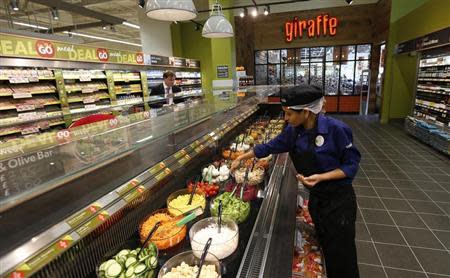British service sector soars in August - PMI
By Andy Bruce LONDON (Reuters) - A rush of new business last month drove Britain's services sector to its fastest growth rate for more than six years, challenging the Bank of England's cautious outlook for the economy a day before a monetary policy meeting. Wednesday's Markit/CIPS UK services purchasing managers' index (PMI) rose to 60.5 in August from 60.2 in July, adding to a run of data suggesting the UK economic recovery is gathering momentum. The reading was the highest since December 2006, holding well above the 50 threshold dividing growth from contraction for the eighth consecutive month. Economists polled by Reuters had predicted growth would slow slightly to 59.0. Instead, order books at companies ranging from banks to restaurants filled at the fastest pace since May 1997, the month Tony Blair became prime minister. Like the previous month, the PMI showed British businesses were at the forefront of Europe's nascent economic recovery, outpacing major euro zone peers that are still grappling for momentum. It suggested Britain's economy is on course to better the 0.7 percent quarterly growth it experienced from April through June in this quarter, and comfortably so. "I wouldn't be surprised to see growth double what the Bank of England is expecting for (this) quarter, because they're currently forecasting 0.6 percent," said George Buckley, chief UK economist at Deutsche Bank. Sterling rose to a 7-1/2 month peak against a trade-weighted basket of currencies and a three-and-a-half month high versus the euro after the data. The composite PMI, which incorporates manufacturing and construction data from earlier in the week, rose to 60.7 from 59.5, its highest level since the series began in 1998. While that is welcome news for Britain's government after roughly three years of stagnation, the data may give BoE Governor Mark Carney pause for thought. He has stressed the economy needs a lot more help from the central bank to nurse it back to health, and the bank does not plan to raise interest rates until unemployment falls to 7 percent, something he forecasts is at least three years away. Some investors and analysts are not convinced he will be able to keep rates low for that long. "We expect the BoE to be forced into tightening monetary policy well before the Q3 2016 date that they are currently suggesting is the earliest point (that) policy tightening will start," said James Knightley, economist at ING. He cited the strength in orders, rising business optimism and employment hiring surveys, and forecasts the Bank will tighten policy in the first half of 2015. However, the BoE's forecast that unemployment will prove slow to fall may be on the mark, as the services PMI showed that firms' hiring slowed to its weakest pace so far this year. Monday's manufacturing survey also showed slowing jobs growth. The bank's ratesetters meet on Thursday, and economists do not expect them to change tack. JOBS MARKET STILL SUBDUED July and August's services PMIs marked the first back-to-back readings above 60 since 1997. Before the 2008-09 recession, such strong rises in the services PMI were often followed by rises in interest rates. However, the depth of the downturn put a stop to that correlation. Even with last quarter's growth, the economy is still around 3 percent smaller than its pre-recession peak in the first quarter of 2008. And although the new orders index hit 61.3 in August from July's 60.0, leaving it just seven ticks shy of the survey record, the sharp fall in the jobs index showed the labour market still has some catching up to do. "If activity and sales can maintain their current growth velocities, then higher payrolls and ... increased wages should hopefully follow suit," said Paul Smith, senior economist from survey compiler Markit. The survey also showed the rise in prices charged to customers slowed slightly last month. That suggests that, at least for now, the upturn in business is unlikely to be the cause of a spike in inflation, a second catalyst for possible policy change identified by the Bank. (Editing by Hugh Lawson, John Stonestreet)



